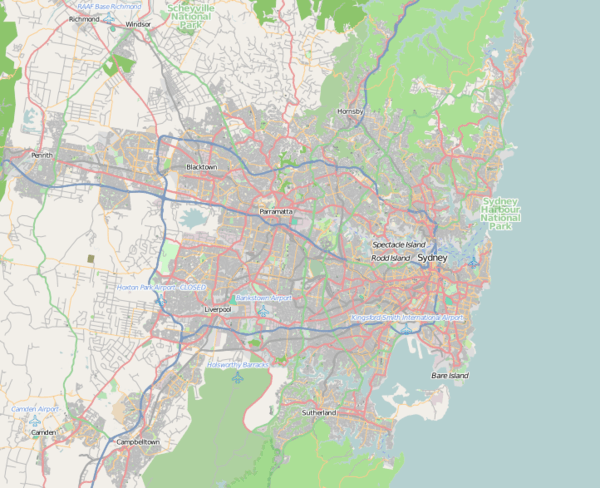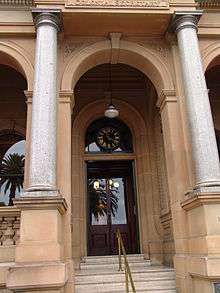Chief Secretary's building
| Chief Secretary's building | |
|---|---|
|
Macquarie Street façade of the Chief Secretary's building | |
 Chief Secretary's building Location in greater Sydney | |
| Former names | Colonial Secretary's building |
| General information | |
| Status | Complete |
| Type | Government administration |
| Architectural style | |
| Address | 121 Macquarie Street, Sydney, New South Wales |
| Country | Australia |
| Coordinates | 33°51′49″S 151°12′44″E / 33.8635°S 151.2123°ECoordinates: 33°51′49″S 151°12′44″E / 33.8635°S 151.2123°E |
| Current tenants | |
| Construction started | 1873 |
| Completed | 1886 |
| Opened | 1881 |
| Cost |
|
| Renovation cost | A$32 million (2005) |
| Client | Colonial Secretary of New South Wales |
| Owner | Government of New South Wales |
| Technical details | |
| Material | |
| Floor count | 5 |
| Design and construction | |
| Architect |
|
| Architecture firm | Colonial Architect of New South Wales |
| Developer | Government of New South Wales |
| Renovating team | |
| Architect | Government Architect's Office |
| Awards and prizes |
|
| Official name | Chief Secretary's Building |
| Type | Built |
| Criteria | a., c., d., e., f. |
| Designated | 2 April 1999 |
| Reference no. | 00766 |
| References | |
| [1][2] | |
The Chief Secretary’s building (originally the Colonial Secretary's building) is a heritage-listed[3] state government administrative building of the Victorian Free Classical architectural style located at 121 Macquarie Street, 65 Bridge Street, and at 44-50 Phillip Street in the Sydney central business district of New South Wales, Australia.
The ornate five-storey public building was designed by Colonial Architect James Barnet and built in two stages, the first stages being levels one to four completed between 1873 and 1881, with Walter Liberty Vernon completing the second stage between 1894 and 1896 when the mansard at level 5 and the dome were added.[1]
The sandstone building was the seat of colonial administration, has been used continuously by the Government of New South Wales, and even today holds the office of the Governor of New South Wales. Its main occupant is the Industrial Relations Commission of New South Wales; several of the larger rooms are now courtrooms.
| “ | ...(this) pile of a building like a veritable 'poem in stone' adorns the northern portion of Macquarie Street. | ” |
| — Illustrated Sydney News, 28 February 1891 | ||
Heritage listing
On 2 April 1999 the building was listed on the New South Wales State Heritage Register with the following statement of significance:[1]
The Chief Secretary's building is of national significance by reason of its historic, social, architectural, aesthetic and scientific values. It embodies, by its construction for and association with, pre-eminently important office and department of the Colonial, later Chief Secretary. This most enduring of political and administrative institutions achieved, through its expansion and growing politicisation, the most far reaching powers of any of the administrative departments of the Colonial bureaucracy. The decisions made in this department affected every level of society in the colony.
After the institution of responsible government in 1856 the office of the Chief Secretary was almost continuously held until the twentieth century by the Premier of NSW further underlining its important role. Several outstanding figures in NSW political life held this office and through it, and the role of the Premier, were able to campaign for the most important political agendas of the time, including, but not exclusively, economic and land reform and Federation.
The locations, size and lavish treatment graphically demonstrate the importance of the departments that were housed there, the social hierarchy of its occupants as well as the practical workings of the fully developed late nineteenth century bureaucracy. The interior finish demonstrates refinement of public taste. Its continual occupation as government offices through to the twentieth century make it possible to demonstrate, through changes made to the fabric, changing community practices such as greater opportunities for women in the workforce.
The building is one of the most significant late nineteenth century architectural works in Sydney. It embodies two of the most significant projects of Barnet and Vernon and was ranked, by contemporary accounts, with pre-eminent public works of the time such as the GPO. It remains a dominant element in the Victorian streetscapes of this part of Sydney.
Its placement in relation to Government House, Parliament House, the Treasury Building and other major departmental offices symbolises the relationship to the office to both political and public offices.
— Statement of significance, New South Wales State Heritage Register.
The building is also listed on the (now defunct) Register of the National Estate.[2]
Architecture
Constructed 1873-1880, the building was designed by colonial architect James Barnet. Its style has been called "Venetian Renaissance" as well as Victorian Free Classical. A fifth floor and dome were added in the 1890s by Barnet’s successor Walter Liberty Vernon in the Victorian Second Empire style,[4] as well as an extension south at 50 Phillip Street. Barnet resented the additions, which lessened the resemblance to his model, the 16th-century Palazzo Farnese in Rome, completed by Michelangelo after Farnese became Pope Paul III. The dome was originally covered in aluminium in 1895-1896, one of the earliest such uses of this metal in the world.
The building features nine life-size statues (six external and three internal) placed according to the administrative function of three parts of the building. The entrances on three streets are labelled in sandstone, directing visitors to the appropriate section.
- The prestigious 121 Macquarie Street entrance is labelled "Colonial Secretary". He occupied the North-East corner office on the First Floor (at the time the top floor, now called Level 3). Sandstone sculptures in the building's exterior personify Mercy, Justice, and Wisdom (top to bottom). Inside stands a marble statue of Queen Victoria.
- The 65 Bridge Street (central) ground floor entrance, one level below, is labelled "Public Entrance". Inside stands a female figure representing New South Wales, a merino at her foot. The NSW Badge, adopted in 1876, is sculpted above in the pediment.[1]
- The 44 Phillip Street entrance is labelled "Secretary for Works" and features a bust of Queen Victoria. The Minister for Public Works had his office in the North-West corner. The external statues personify Art, Science, and Labour. The internal statue on this side is of Edward VII when Prince of Wales.
The internal Carrara marble statues are by Giovanni Giuseppe Fontana. He was born in Italy (1821) but lived and worked in England, dying in London in December 1893. The external sandstone statues are by Achille Simonetti (Rome 1838 - Birchgrove 1900), who in 1874 established a large studio in Balmain.[5]
The interior features Australian Red Cedar and ornate tiles, plaster ceilings and cornices.
Historical significance
The building's design and furnishings reflect in large part the taste of the first Colonial Secretary, Sir Henry Parkes.
The Executive Council Chamber (originally known as the Cabinet Room) was the venue for several meetings that led to Federation, including the Australasian Federal Convention of 1891.[6] The room is very well preserved, with period furniture, paintings of a young Queen Victoria and James Cook, and bronzes of several British Prime Ministers including Palmerston. Some of the objects on display were acquired from the 1879 Sydney International Exhibition.
Extensive restorations between 1988 and 2005 were performed with a degree of care that set new standards.[7][8] It is open to the public; several historical displays interpret the building's history, and the glass lift shafts allow archaeological viewing of the construction.
Gallery
 Macquarie Street entrance signed 'Colonial Secretary'. A statue of Queen Victoria is barely visible through the door.
Macquarie Street entrance signed 'Colonial Secretary'. A statue of Queen Victoria is barely visible through the door.- The stairwell and original wire cage lift shaft, still in use.
See also
References
- 1 2 3 4 "Chief Secretary's Building". New South Wales State Heritage Register. Office of Environment and Heritage. Retrieved 30 December 2016.
- 1 2 "Chief Secretarys Building, 121 Macquarie St, Sydney, NSW, Australia (Place ID 1824)". Australian Heritage Database. Department of the Environment. Retrieved 7 October 2017.
- ↑ Australian Heritage Commission (1981). The Heritage of Australia: the illustrated register of the National Estate. South Melbourne: The Macmillan Company of Australia in association with the Australian Heritage Commission. p. 94. ISBN 978-0-333-33750-9.
- ↑ Government Architect's Office; Group GSA Pty Ltd (2003). "Chief Secretary's Building". architecture.com.au. The Royal Australian Institute of Architects. Retrieved 30 December 2016.
- ↑ Hutchison, Noel S. (1976). "Simonetti, Achille (1838–1900)" (Hardcopy). Australian Dictionary of Biography. National Centre of Biography, Australian National University. Retrieved 30 December 2016.
- ↑ "Search: Australian Constitutional Conventions of 1890s". Parliament of Australia. Retrieved 7 October 2017.
- ↑ "Heritage: Chief Secretary's Building". Government Architect's Office. Department of Public Works, Government of New South Wales. 2005. Archived from the original on 29 August 2007. Retrieved 7 October 2017.
- ↑ "Heritage: Chief Secretary's Building" (PDF). Government Architect's Office. Department of Public Works, Government of New South Wales. December 2005. Archived from the original (PDF) on 29 August 2007. Retrieved 7 October 2017.
Attribution
![]()
External links
| Wikimedia Commons has media related to Chief Secretary’s Building, Sydney. |